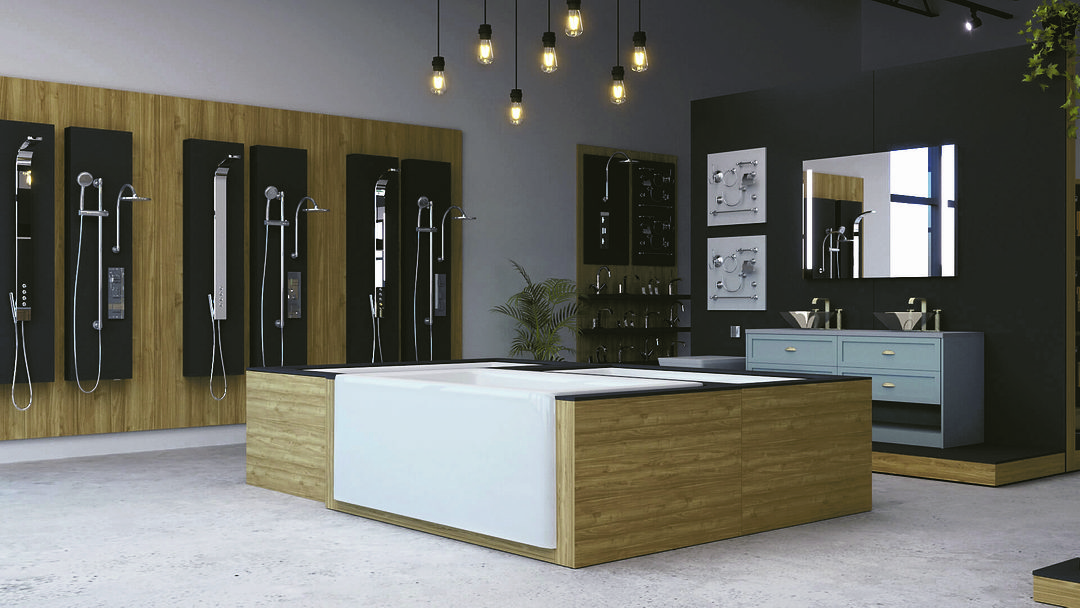A New Approach to Inspiring Client Confidence
Tap into technology, product curation and new ways to use showroom space to build confidence and lasting relationships with your clientele.

With renovations going strong despite higher prices, delays and supply chain issues, this will be a year to prove to your clients that you are the best partner for them. It’s time to show and not just tell people what your showroom can do for them to help meet their home improvement goals. Over the coming months, what you do with your showroom will be a key part of that message.
What applies to retail clients works for designer and building professionals; they need to be confident they are sending their clients to the right place. They should feel they are a valued part of the showroom business and that the space includes all the tools they need to do the best job for their clients.
You can build stronger partnerships with long-term returns by offering a place where design and product selection is a seamless, enjoyable process.
Showrooms should strike a balance between functionality and aesthetics. It’s time to put thought into optimizing every square inch of the showroom, not necessarily through products but through client-forward strategies. Putting effort into making a space that works for clients will have an impact extending to the showroom’s business goals through increased sales per square foot.
Take a new approach in the coming months by tapping into technology, product curation and new ways to use showroom space to build confidence and lasting relationships with your clientele.
Product: Less is More
More and more, clients and designers are looking for spaces that make product selection easy and fun. To make the shopping experience more enjoyable and increase sales, product curation is the up-and-coming way to merchandise a showroom. Product curation takes research into your target clientele and your local market, but you also possess a wealth of knowledge in your sales records and your staff, who know what clients are asking for.
Once you’ve put out the carefully chosen items that speak to your clientele, there are plenty of ways to use technology to show additional products, finishes and options.
From the customer’s point of view, product curation makes it easier to find products that match their needs and tastes. They feel they’ve chosen to shop in a place that understands their needs and wants to make their decision-making an enjoyable process. It’s exactly the type of personalized experience consumers expect online and offline.
It’s ultimately about inspiration and aspiration. It shows you get your customers — not only what they need, but also what they want. When the products on display are those your client base is looking for, it’s far less likely they will look elsewhere. It may seem counterintuitive but from a sales point of view, having less on display makes those products look more exclusive, leading to better margins overall.
Product curation also provides an opportunity to demonstrate the showroom’s product and design knowledge while strengthening the brand. Keeping less product on the floor and focusing on displaying the very best is facilitated by using technology in and out of the showroom.
Technology:
Versatile Applications
Technology is a pivotal element of a good showroom experience these days, where so much of the buying journey starts online. To attract and convince clients to come in, many showrooms with an online presence now strengthen that with a 360-viewing experience, with video walkthroughs offering clients a chance to explore the showroom’s offerings before they visit.
After speaking to our clients in the showroom world, we have noted that these online video experiences have been especially important since the COVID-19 pandemic began. Some of their customers have been hesitant to come into a physical store and want to ensure it’s the right place before going in.
While it’s great that showrooms can now be accessed online, many focus more on the products than how the showroom itself is presented. With more people choosing where to go based on what a space looks like, showrooms need to put their best foot forward in terms of design before putting video walkthroughs online.
Within the showroom, technology has numerous applications. It can be incorporated seamlessly into the design and the overall experience with well-placed tablets or screens showing the history and services of the showroom. Clients can interact with the screens to learn more about the brand and feel more invested in the company and the people with whom they will be working.
From a product point of view, tablets and screens are almost essential, especially in showrooms with less merchandise on display. Screens are the best choice for showing items in different styles and finishes, as well as product demos.
Aside from using screens and tablets, many showrooms implement QR codes into their sales practice. Having these small, discreet tags on signage or products allows clients to learn more about the products they are interested in, so they are more informed before meeting with designers or sales staff.
It’s even better if they can scan their QR codes to an app that captures their information. With that list in hand and saved in the showroom’s database, clients can make much of the product selection on their own and review it later with showroom staff.
If you’re hesitant to invest in technology, it’s important to consider that clients are more likely than ever to check product inventory before coming into the physical store and need a place to do so. They are more aware of supply chain issues and prefer to know if it’s worth going in before leaving the house, so a well-built and always updated website is key.
Once they’re in, clients feel less pressure if they can educate themselves about the products.
Aside from providing clients with the hybrid experience they’ve come to expect, technology is the ideal companion to a more curated showroom. It allows people to see what is available and when, so there is less need to keep everything on display in the physical space. The showroom becomes a place of inspiration and support, especially as home remodeling remains strong in 2022.
Today’s plumbing showrooms will need to shift their focus from a product-packed space to something less cluttered because clients expect to see their lifestyles and habits reflected in shopping environments. In the decorative plumbing world, clients coming in for home improvement projects need to know that whatever they choose for their homes, it will be the perfect fit — and they chose the best possible place to make that happen.
Bringing this vision to life will require showrooms to combine practical merchandising strategies, retail trends and investment in technology — but it will be well worth the effort.





